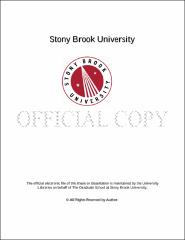| dc.identifier.uri | http://hdl.handle.net/11401/76449 | |
| dc.description.sponsorship | This work is sponsored by the Stony Brook University Graduate School in compliance with the requirements for completion of degree. | en_US |
| dc.format | Monograph | |
| dc.format.medium | Electronic Resource | en_US |
| dc.language.iso | en_US | |
| dc.publisher | The Graduate School, Stony Brook University: Stony Brook, NY. | |
| dc.type | Dissertation | |
| dcterms.abstract | Protein dimerization is involved in many essential biological processes like gene expression, allosteric regulation, enzymatic activation and signal transduction. However, our understanding about dimerization mechanisms is limited despite of the progress made. In this work, we applied molecular dynamics simulation with all-atom structure-based model to the investigation often commonly studied regulatory dimers. Through the combinational analysis of intrinsic energy funnels, density of states, thermodynamic free energy landscapes, phi-values of transition states, and kinetic simulations, new and detailed mechanisms of dimerization and their coupling with monomer folding are revealed, in good agreements with existing experimental evidences and suggestions. We found five distinct representative strategies from ten dimers, demonstrating the high diversity and uniqueness in protein dimerization mechanisms, which challenge, or complement, the conventional concepts of two-state (obligatory) and three-state (non-obligatory) dimers. The all-atom structure-based model used here is demonstrated to have better representation for hydrogen bonds and hydrophobic packing, be able to distinguish disulfide bonds from native contact pairs, and give more detailed agreements with experiments than the previous course-grained structure-based model. Lambda Cro repressor is one of the most studied dimeric transcription factors. But there is still an unsettled debate for decades about whether it is a two-state dimer or three-state dimer. We provide a new mechanism model that can reconcile these seemingly conflicting (mutually exclusive) experimental results. From simulations with all-atom structure-based model, we observe that the dimerization process of Lambda Cro repressor starts from one folded monomer with one unfolded monomer. Intra-subunit folding and inter-subunit binding are half-coupled, in a fly-casting manner. | |
| dcterms.available | 2017-09-20T16:50:18Z | |
| dcterms.contributor | Wang, Jin | en_US |
| dcterms.contributor | Li, Xiaolin | en_US |
| dcterms.contributor | MacCarthy, Thomas | en_US |
| dcterms.contributor | Fortmann, Charles. | en_US |
| dcterms.creator | Yao, Yuan | |
| dcterms.dateAccepted | 2017-09-20T16:50:18Z | |
| dcterms.dateSubmitted | 2017-09-20T16:50:18Z | |
| dcterms.description | Department of Applied Mathematics and Statistics. | en_US |
| dcterms.extent | 110 pg. | en_US |
| dcterms.format | Application/PDF | en_US |
| dcterms.format | Monograph | |
| dcterms.identifier | http://hdl.handle.net/11401/76449 | |
| dcterms.issued | 2014-12-01 | |
| dcterms.language | en_US | |
| dcterms.provenance | Made available in DSpace on 2017-09-20T16:50:18Z (GMT). No. of bitstreams: 1
Yao_grad.sunysb_0771E_12162.pdf: 15573159 bytes, checksum: af5951f7c1c4c8c073dcce0f150e6676 (MD5)
Previous issue date: 1 | en |
| dcterms.publisher | The Graduate School, Stony Brook University: Stony Brook, NY. | |
| dcterms.subject | coupled binding-folding, Lambda Cro repressor, molecular dynamics, protein dimer, structure-based model, three-state dimer | |
| dcterms.subject | Applied mathematics | |
| dcterms.title | Protein Dimerization Mechanisms Study with Molecular Dynamics Simulation | |
| dcterms.type | Dissertation | |

